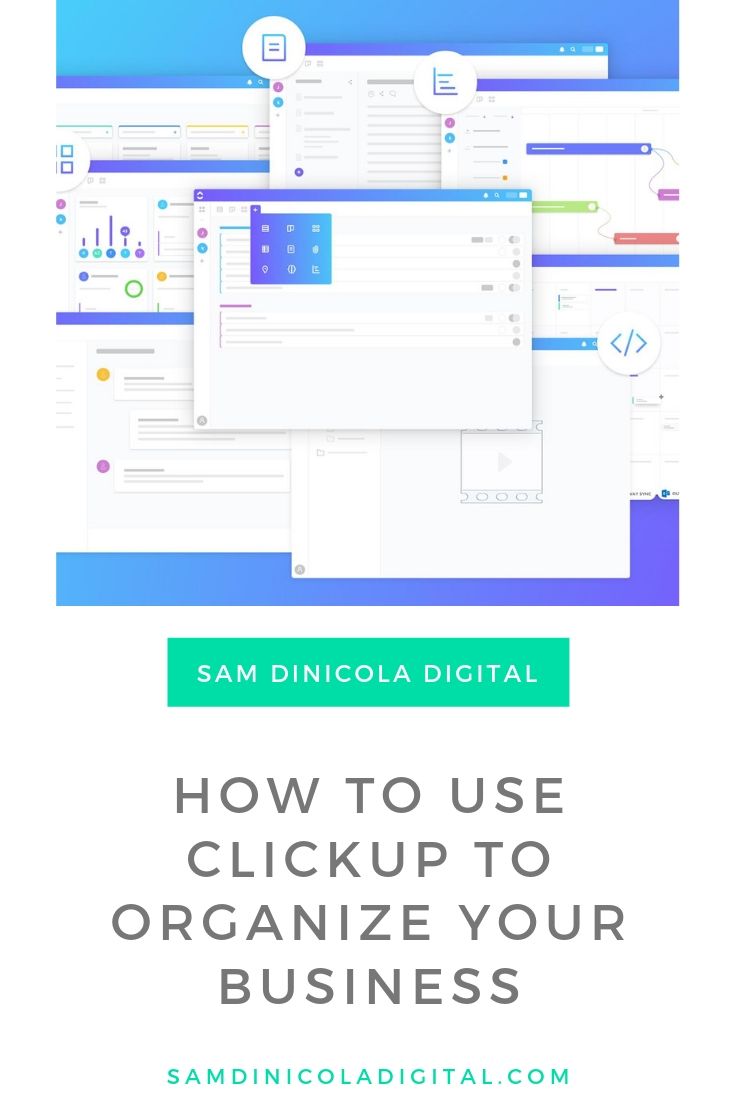How to Use Clickup to Organize Your Business
I have a confession...I'm kind of Type A. I love planning. I love making lists. And I love being organized. There are a few tools and apps I use to keep my business and my life running as smoothly as possible, and ClickUp is the most important tool of them all.
ClickUp is a project management tool that allows you to create different projects, make multiple lists within each project, and add as many tasks as you want to each list. You can assign a person (great if you have family members or team members using ClickUp), you can assign start and due dates, you can assign each task a priority. There's little that this holy grail of organization can't do. I used to use Asana for most of this but after I heard about ClickUp and compared some of the features, ClickUp is the way to go!
Here's how I use ClickUp to organize my business and my life.
Simple But Capable Hierarchy
When you're creating your ClickUp account you will first notice, and probably be a little confused by the hierarchy of lists and tasks. You have a team which could include family members or team members that you bully into using ClickUp. You can belong to multiple teams but you can also easily keep everything in a single team.
Within your team, you will create "Spaces." I have created spaces for my main products and services, I have a space for family stuff, I have a space dedicated to goals & planning, and I have spaces for all of my smaller side hustles. You can add team members to specific spaces so if you want to use ClickUp with your clients, then you should create an individual space for each client, add the client to your team, then give the client permissions to see only their space. This is completely up to you but if you plan on adding a few people to your team might be a good option to make sure users only see what you want them to see.
For now, I only use ClickUp with my husband and VA so my clients are organized into their own projects within each space. So I have a Coaching space, and within that space, each coaching client has their own Project. In each project, you can have multiple lists so in my Projects for Marketing Strategy clients, I have a list for social, email marketing, website, and misc for each of them. Then the tasks live within each specific list.
So the hierarchy is Team --> Space --> Project --> List --> Task.
My Favorite ClickUp Features
I mentioned earlier that I used to use Asana for project management and while it was good, there were a few features it was missing and that ClickUp does wonderfully.
Recurring Tasks
One of the main items I love about ClickUp is the recurring tasks. You can set recurring tasks in both tools but with ClickUp you can set a task to recur in specific intervals (every day, every 2 weeks, every 3 months), and you can set it to happen at a specific date (4th of the month, every other Tuesday, last week of the quarter). The recurring tasks are a game changer in terms of systematizing your business. I have recurring tasks for confirming retainer clients have paid, for my website maintenance, even for watering my plants (I have a black thumb). But what I love recurring tasks for is goal setting and habit tracking. I have recurring tasks to review my weekly goals on Monday mornings, to review my monthly goals at the beginning of the month, etc. I set these reviews to recurring so that I never forget or procrastinate on taking a few minutes to review and look at the bigger picture in my business. By creating recurring tasks I can set them once and not think about them again until I have to complete them the next time. You can set your recurring tasks to automatically reschedule as soon as you mark them as completed so it takes most of the scheduling work off your plate.
Dependencies
Dependencies are an amazing tool for anyone who has a specific order they like to do things in. If you are working on a web design project or coaching clients are working their way through your program, you want to set up dependencies. These allow you to create all the tasks that will go into a project and set a start and due date for those tasks. But if a task is marked as dependent on a task that comes before it, you can set it to automatically adjust the dates of all tasks that come after. There's no need to manually update project timelines because you missed one deadline. Again, this is amazing for anyone managing a project but I'm sure there are plenty of other ways you can think to use it, maybe for content creation and approval?
Custom Task Statuses
Another amazing feature of ClickUp is that you can set custom statuses for tasks and they can be unique to each of your spaces. This means you can do more than set a task to simply "open" or "closed." I know a lot of people who use custom statuses for content planning. You can create custom statuses like draft, needs approval, needs formatting, scheduled, promoted, etc. The statuses are completely custom so create ones that make sense for your processes and projects.
Subtasks
Similar to the task dependencies feature, subtasks are a great way to pair relevant tasks together. You can create a task like "post blog" and have subtasks under that like write blog, add links, format in Wordpress, proof read, schedule, promote on social, etc. That way, you can view all of the subtasks that are relevant to that one task. When you're looking at all of your tasks in a space or in a project, you can set ClickUp to show only your tasks, or to show tasks and subtasks. I love this for new projects or goals that I'm setting. I think about the main objective like "sell coaching services" then I break that out into larger task items but each of those gets separated into subtasks. This helps me to take my big scary goals and turn them into smaller goals that I feel I can accomplish. It also helps me get an idea of how long it will realistically take to accomplish the larger goals and the big picture projects. Subtasks help keep everything grouped together in a way that makes sense. I get really into the nitty-gritty with scheduling tasks, down to very simple items, so being able to include subtasks is a great way to keep all of those smaller to-dos organized.
The Takeaway
If you're not using a project and task management tool for your business or even just your personal life, I highly suggest you start immediately. If you're using Trello or Asana, I would suggest taking a look at some of the other awesome features from ClickUp and seeing if it would work better for you. It felt daunting to move everything from Asana into ClickUp but I did it bit by bit over a week or so while adding any new tasks straight into ClickUp and it was pretty painless overall. Sign up for ClickUp here.
If you’re looking for even MORE support on how to set up ClickUp for your business, purchase my Course, ClickUp for Entrepreneurs, and I’ll walk you through 10 self-paced modules so you can set up ClickUp in a way that will work well for you and your business.















